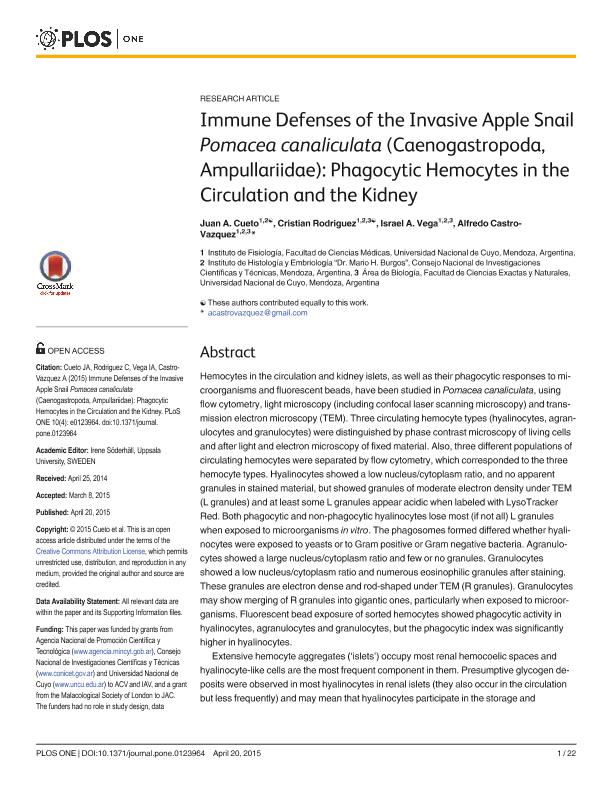Mostrar el registro sencillo del ítem
dc.contributor.author
Cueto, Juan Agustin

dc.contributor.author
Rodriguez, Cristian
dc.contributor.author
Vega, Israel Aníbal

dc.contributor.author
Castro Vazquez, Alfredo Juan

dc.date.available
2018-04-06T13:44:29Z
dc.date.issued
2015-04
dc.identifier.citation
Cueto, Juan Agustin; Rodriguez, Cristian; Vega, Israel Aníbal; Castro Vazquez, Alfredo Juan; Immune Defenses of the Invasive Apple Snail Pomacea canaliculata (Caenogastropoda, Ampullariidae): Phagocytic Hemocytes in the Circulation and the Kidney; Public Library of Science; Plos One; 10; 4; 4-2015; 1-22
dc.identifier.issn
1932-6203
dc.identifier.uri
http://hdl.handle.net/11336/41050
dc.description.abstract
Hemocytes in the circulation and kidney islets, as well as their phagocytic responses to microorganisms and fluorescent beads, have been studied in Pomacea canaliculata, using flow cytometry, light microscopy (including confocal laser scanning microscopy) and transmission electron microscopy (TEM). Three circulating hemocyte types (hyalinocytes, agranulocytes and granulocytes) were distinguished by phase contrast microscopy of living cells and after light and electron microscopy of fixed material. Also, three different populations of circulating hemocytes were separated by flow cytometry, which corresponded to the three hemocyte types. Hyalinocytes showed a low nucleus/cytoplasm ratio, and no apparent granules in stained material, but showed granules of moderate electron density under TEM (L granules) and at least some L granules appear acidic when labeled with LysoTracker Red. Both phagocytic and non-phagocytic hyalinocytes lose most (if not all) L granules when exposed to microorganisms in vitro. The phagosomes formed differed whether hyalinocytes were exposed to yeasts or to Gram positive or Gram negative bacteria. Agranulocytes showed a large nucleus/cytoplasm ratio and few or no granules. Granulocytes showed a low nucleus/cytoplasm ratio and numerous eosinophilic granules after staining.These granules are electron dense and rod-shaped under TEM (R granules). Granulocytes may show merging of R granules into gigantic ones, particularly when exposed to microorganisms.Fluorescent bead exposure of sorted hemocytes showed phagocytic activity in hyalinocytes, agranulocytes and granulocytes, but the phagocytic index was significantly higher in hyalinocytes.Extensive hemocyte aggregates (?islets?) occupy most renal hemocoelic spaces and hyalinocyte-like cells are the most frequent component in them. Presumptive glycogen deposits were observed in most hyalinocytes in renal islets (they also occur in the circulation but less frequently) and may mean that hyalinocytes participate in the storage and circulation of this compound. Injection of microorganisms in the foot results in phagocytosis by hemocytes in the islets, and the different phagosomes formed are similar to those in circulating hyalinocytes. Dispersed hemocytes were obtained after kidney collagenase digestion and cell sorting, and they were able to phagocytize fluorescent beads. A role for the kidney as an immune barrier is proposed for this snail.
dc.format
application/pdf
dc.language.iso
eng
dc.publisher
Public Library of Science

dc.rights
info:eu-repo/semantics/openAccess
dc.rights.uri
https://creativecommons.org/licenses/by-nc-sa/2.5/ar/
dc.subject
Gastropod Immunology
dc.subject
Apple Snail Biology
dc.subject
Ampullariidae
dc.subject
Invasive Species
dc.subject
Flow Cytometry
dc.subject
Transmission Electron Microscopy
dc.subject
Confocal Laser Scanning Microscopy
dc.subject
Angiostrongylus Cantonensis
dc.subject
Rat Lung Worm
dc.subject
Eosinophilic Meningitis
dc.subject.classification
Otras Ciencias Biológicas

dc.subject.classification
Ciencias Biológicas

dc.subject.classification
CIENCIAS NATURALES Y EXACTAS

dc.title
Immune Defenses of the Invasive Apple Snail Pomacea canaliculata (Caenogastropoda, Ampullariidae): Phagocytic Hemocytes in the Circulation and the Kidney
dc.type
info:eu-repo/semantics/article
dc.type
info:ar-repo/semantics/artículo
dc.type
info:eu-repo/semantics/publishedVersion
dc.date.updated
2018-03-27T13:35:11Z
dc.journal.volume
10
dc.journal.number
4
dc.journal.pagination
1-22
dc.journal.pais
Estados Unidos

dc.journal.ciudad
San Francisco
dc.description.fil
Fil: Cueto, Juan Agustin. Consejo Nacional de Investigaciones Científicas y Técnicas. Centro Científico Tecnológico Conicet - Mendoza. Instituto de Histología y Embriología de Mendoza Dr. Mario H. Burgos. Universidad Nacional de Cuyo. Facultad de Cienicas Médicas. Instituto de Histología y Embriología de Mendoza Dr. Mario H. Burgos; Argentina. Universidad Nacional de Cuyo. Facultad de Ciencias Médicas; Argentina
dc.description.fil
Fil: Rodriguez, Cristian. Consejo Nacional de Investigaciones Científicas y Técnicas. Centro Científico Tecnológico Conicet - Mendoza. Instituto de Histología y Embriología de Mendoza Dr. Mario H. Burgos. Universidad Nacional de Cuyo. Facultad de Cienicas Médicas. Instituto de Histología y Embriología de Mendoza Dr. Mario H. Burgos; Argentina. Universidad Nacional de Cuyo. Facultad de Ciencias Médicas; Argentina. Universidad Nacional de Cuyo. Facultad de Ciencias Exactas y Naturales; Argentina
dc.description.fil
Fil: Vega, Israel Aníbal. Universidad Nacional de Cuyo. Facultad de Ciencias Médicas; Argentina. Universidad Nacional de Cuyo. Facultad de Ciencias Exactas y Naturales; Argentina. Consejo Nacional de Investigaciones Científicas y Técnicas. Centro Científico Tecnológico Conicet - Mendoza. Instituto de Histología y Embriología de Mendoza Dr. Mario H. Burgos. Universidad Nacional de Cuyo. Facultad de Cienicas Médicas. Instituto de Histología y Embriología de Mendoza Dr. Mario H. Burgos; Argentina
dc.description.fil
Fil: Castro Vazquez, Alfredo Juan. Universidad Nacional de Cuyo. Facultad de Ciencias Médicas; Argentina. Consejo Nacional de Investigaciones Científicas y Técnicas. Centro Científico Tecnológico Conicet - Mendoza. Instituto de Histología y Embriología de Mendoza Dr. Mario H. Burgos. Universidad Nacional de Cuyo. Facultad de Cienicas Médicas. Instituto de Histología y Embriología de Mendoza Dr. Mario H. Burgos; Argentina. Universidad Nacional de Cuyo. Facultad de Ciencias Exactas y Naturales; Argentina
dc.journal.title
Plos One

dc.relation.alternativeid
info:eu-repo/semantics/altIdentifier/doi/http://dx.doi.org/10.1371/journal.pone.0123964
dc.relation.alternativeid
info:eu-repo/semantics/altIdentifier/url/http://journals.plos.org/plosone/article?id=10.1371/journal.pone.0123964
Archivos asociados
